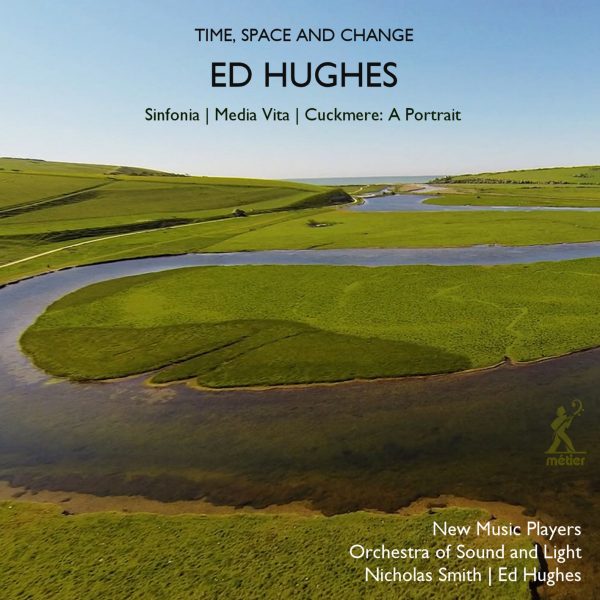Classical Notes
A highlight of the 2018 Brighton Festival was Cuckmere: A Portrait, Cesca Eaton’s film depicting a year in the life of the River Cuckmere and Haven with live score by Ed Hughes (b.1968), performed by the Orchestra of Sound and Light. The recording of that performance has now been released as part of Time, Space and Change, bringing together three works by Hughes spread over nearly 30 years of his career. Hughes is Professor of Composition at the University of Sussex, and has a wide-ranging repertoire of compositions to his name, including music for silent films by Sergei Eisenstein and Yasujiro Ozu, opera, orchestral and chamber works. Eaton’s film of the river Cuckmere is incredibly beautiful and even moving, as it pans in and out from the journey down the river’s course to the close up detail of the flora and fauna along the way. Hughes captures this in music that equally contrasts fine detail (stuttering shivers in Winter, and birdlike ripples in Spring, for example), with an overall relentless trajectory, using running scales, and gently chugging rhythms in Autumn, leading through to the final rhythmic energy of Summer, with rapid movement over a slowly rising bass line leading to a satisfying arrival at the conclusion. Having seen the film performance, the images of the beautiful landscape remain in my mind, and Hughes’ music brings them straight back in this incredibly effective piece.
Media Vita comes from much earlier in Hughes’ composition career (1991), but was also performed first at the Brighton Festival. A piano trio, it is performed here by members of the New Music Players, founded by Hughes in 1990. The harmonic language here is dense and Hughes launches straight into motion, with intense, independently moving lines from the three instruments shifting and clashing. There is a sense of urgency, even frenzy, and an uneasy shifting of sands as the piano winds chromatically beneath slowly moving string lines. The inspiration here was the motet of the same name by John Sheppard (1515-1558), and that influence of English fifteenth and sixteenth century composers is picked up once again in the larger scale Sinfonia (2018). Here, the six movements variously draw on English folk song, as well as works by Cooke, Dunstaple, Tallis and Gibbons. Elements of the sources are used in highly imaginative ways, such as the basic chromaticisms of Cooke’s motet Stella Celi Extirpavit spaced out in time, and the diatonic harmonies of Dunstaple’s Veni Sancte Spiritus surrounded by swirling chromatic movement. There’s even a hint of car horns blaring through the urban landscape in the bouncing rhythms of In Nomine. In these six short movements, Hughes creates a fascinating soundworld with hints of earlier musical traditions within a complex tapestry of modern orchestral colours. The New Music Players, under Nicholas Smith, bring this to life with great precision and energy.
@divineartrecordingsgroup
A First Inversion Company
Registered Office:
176-178 Pontefract Road, Cudworth, Barnsley S72 8BE
+44 1226 596703
Fort Worth, TX 76110
+1.682.233.4978









![Listen to the full suite of Marcel Dupré’s Variations Sur un Noël, Op. 20 from Alexander Ffinch’s #Expectations release today! listn.fm/expectations [in bio]](https://scontent-dfw5-1.cdninstagram.com/v/t51.71878-15/588904367_2327488161082898_8709236950834211856_n.jpg?stp=dst-jpg_e35_tt6&_nc_cat=105&ccb=7-5&_nc_sid=18de74&efg=eyJlZmdfdGFnIjoiQ0xJUFMuYmVzdF9pbWFnZV91cmxnZW4uQzMifQ%3D%3D&_nc_ohc=b5g9hiAMsPAQ7kNvwFAzaYv&_nc_oc=AdkB89uQb4caMJmfq6K5bEmB-ZcmPwU0IMowaL643vXP8r7ivqTlyPgpIp0DqJZYe8XX_RepHMv9w7JFCc0b6m3c&_nc_zt=23&_nc_ht=scontent-dfw5-1.cdninstagram.com&edm=ANo9K5cEAAAA&_nc_gid=IDagRwI-OjxT5Zua44swHA&oh=00_AfnrxgvU6quYCSIyBhOW94-WC20ozJK14n13NogveZoaRg&oe=694DF0AA)

![“the ‘Manteca’ Paraphrase – a rare foray into the two-piano medium but here played double-tracked – exudes a panache of which Dizzy Gillespie would surely have approved.… [a] recital well worth investigating.” —Gramophone Magazine with high praise for Ophelia Gordon's debut release, Kapustin: Between the Lines!](https://scontent-dfw5-3.cdninstagram.com/v/t51.82787-15/598796470_18303255136283342_540941604740887837_n.jpg?stp=dst-jpg_e35_tt6&_nc_cat=108&ccb=7-5&_nc_sid=18de74&efg=eyJlZmdfdGFnIjoiRkVFRC5iZXN0X2ltYWdlX3VybGdlbi5DMyJ9&_nc_ohc=q503tFzUYEUQ7kNvwEOwB0i&_nc_oc=AdkapVSnGlJCjUEsWNfpJIRY8LI3qED4ZElzq0enxmc16g_jBVBndon7rSh7XiR9t08eXlsuRz3YK2lTlenkGFU4&_nc_zt=23&_nc_ht=scontent-dfw5-3.cdninstagram.com&edm=ANo9K5cEAAAA&_nc_gid=IDagRwI-OjxT5Zua44swHA&oh=00_AfnmNqbSt2iJamZlFh_I4RDMVlqxsWl8D-7NBObOIuzhHA&oe=694E0344)
